TMAG Customs House, Hobart Tuesday 3 July @8 pm
All are welcome, free lecture.
In the past decade the field of astronomy has been building towards a revolution in the way we measure distances and other fundamental physical properties of the stars in our home galaxy, the Milky Way. The rapid increase in detector sensitivity and computing power in the 21st century has enabled both ground-based and space-based astronomy missions to survey enormous areas of the sky with unprecedented precision in the astrophysical parameters.
Andrew will discuss some of the most significant recent developments to come out of this “big data” revolution, which range from improved knowledge of the frequency and masses of planets around nearby stars, the distribution of luminous and dark matter in the Milky Way, and the forensics of working out how the galaxy itself was assembled by infalling matter over billions of years.
Dr Andrew Cole is Associate Professor in Physics and Astronomy and the Director of the Greenhill Observatory, the home of UTAS optical astronomy research infrastructure. Dr Cole studies the processes and effects that govern the evolution of matter in the Universe from the Big Bang to the present day. Essentially, how things came to be from the beginning of time as we know it. Along with many who came before him and undoubtedly many to follow, he is driven by an innate curiosity, stubbornness and a sense of adventure. Dr Cole uses the UTAS 1.3-metre Harlingten telescope to search for exoplanets around stars in the direction towards the centre of the Mil ky Way by analysis of gravitational microlensing light curves.
ky Way by analysis of gravitational microlensing light curves.
